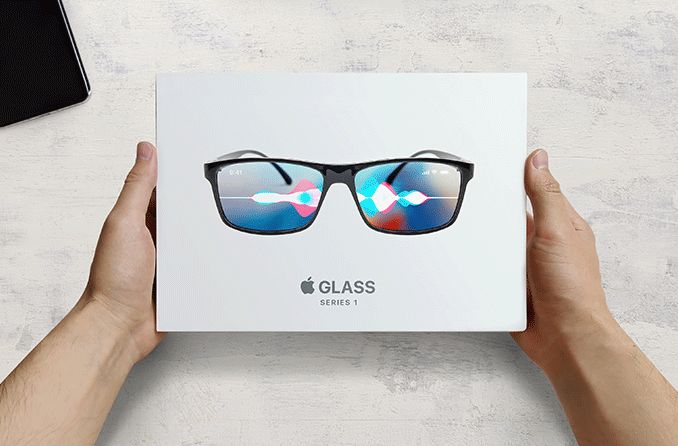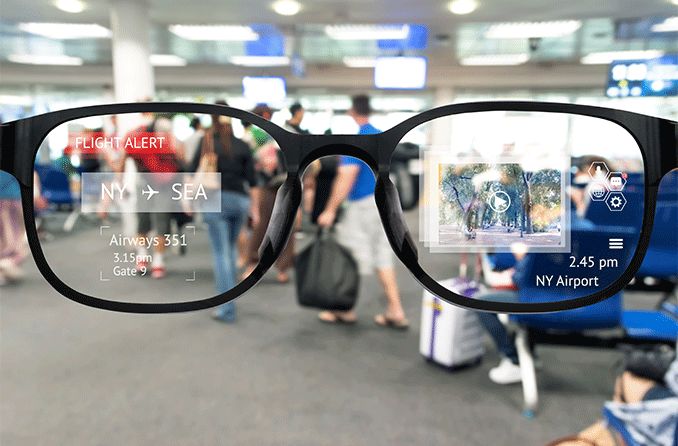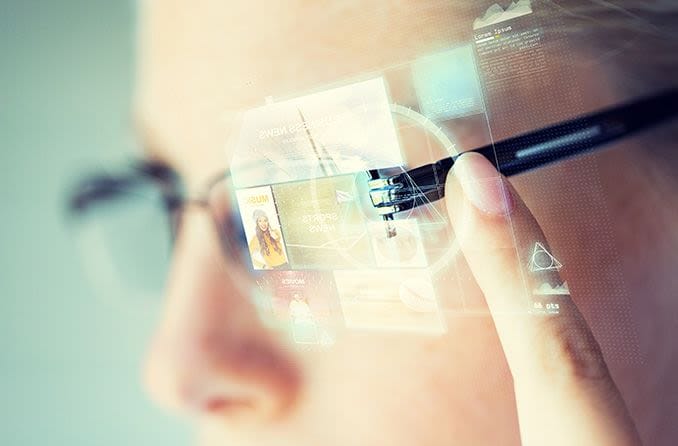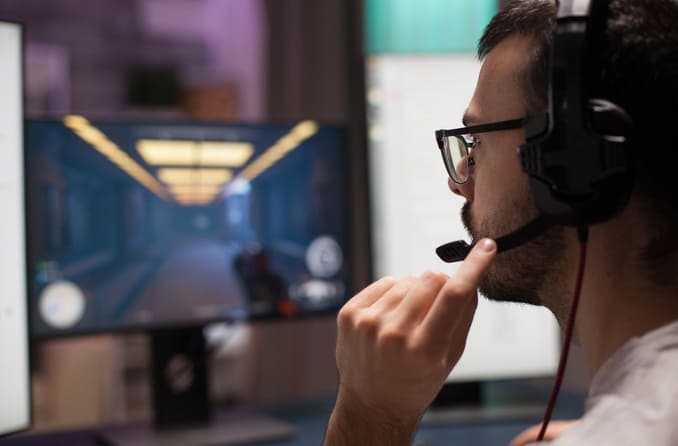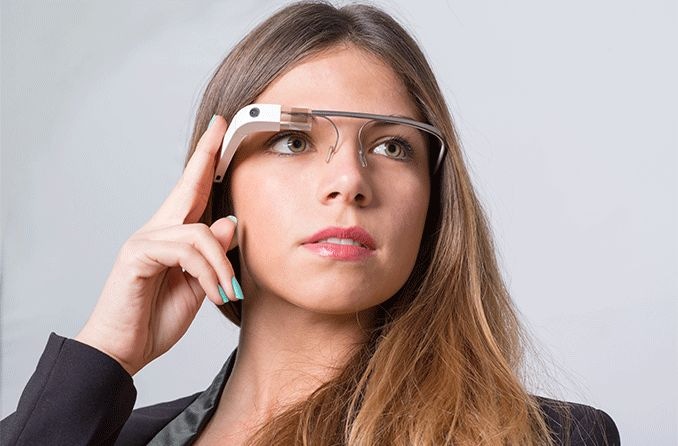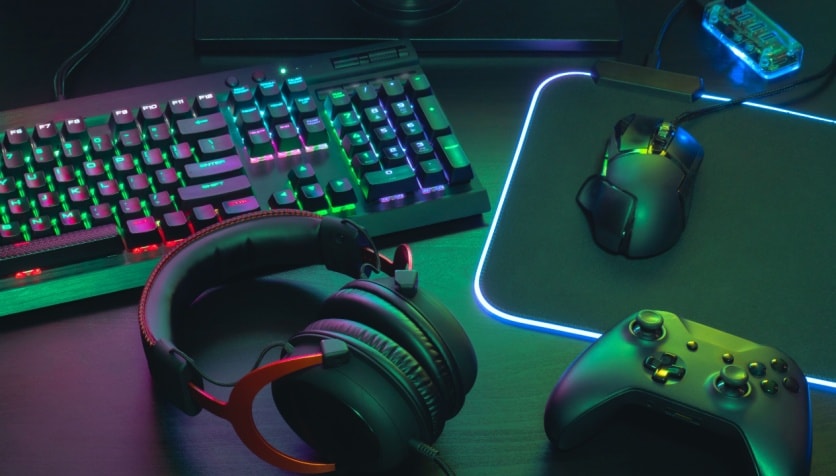Apple augmented reality glasses may be on the horizon
If you were wearing augmented reality glasses right now, you could pull up this article right in front of your eyes without ever looking at your phone or computer screen.
And if speculations are correct that Apple is creating their own augmented reality glasses, that very scenario could be possible in just a few years.
Today, it seems clear that Apple has smart glasses in the works. But the details about the glasses are still hazy. Apple has been very quiet about the prospect of their release. Most information comes from noted technology leakers or is inferred from analyzing new Apple patents.
The concept of augmented reality (AR)-enabled glasses by Apple has been circulating for years. Apple’s AR-related hardware and software patents date back to 2015. There were immediately whispers about the possibility of Apple smart glasses with AR capabilities.
In 2017, Apple released ARKit — a software development tool that allows developers to create apps that include AR. Even though ARKit was made for developing apps for current iOS products, Apple’s new focus on AR sparked rumors that the company was gearing up for an AR device.
Then, in 2019, a new patent appeared that mentioned an “adjustable opacity system” with lenses that automatically darken when exposed to sunlight — similar to the photochromic lenses that are standard in certain types of eyeglasses.
After that, Apple’s virtual glasses went from mere speculation to something that could actually happen.
Nothing about Apple Glasses is set in stone. But based on recent (as of this writing) leaks from some of the most well-known and reliable sources, we’re starting to get a picture of what we can reasonably expect.
Here’s what we (probably) know so far about Apple’s smart glasses:
Apple smart glasses may simply be called Apple Glass
“Apple Glass” sounds remarkably similar to “Google Glass” — Google’s 2014 attempt at smart glasses. Of course this name could change. But for now, many industry pundits have already started using the name.
Apple AR glasses vs. Apple VR glasses
Augmented reality and virtual reality are similar concepts, but there are a few key differences.
Augmented reality (AR) adds to your field of vision. It superimposes digital elements, such as words or pictures of cartoon characters, into the real world around you.
One of the most well-known examples of AR is Pokémon Go, launched in July 2016 from the small gaming company Niantic. When playing, you “see” Pokémon characters walking down the street, hanging out in the park, and seemingly mingling with their surroundings. The goal is to catch and collect the virtual creatures. Pokémon Go uses your smartphone’s GPS, clock and gyro sensors (the sensors that can detect rotation and changes in orientation) to make this impressive game possible.
The Swedish furniture giant IKEA also got into the AR game when they created an app for iOS devices. The app allows you to take a picture of a location in your home and then “place” a piece of furniture there to see how it would look.
Apple will most likely go the AR route for glasses. The Apple augmented reality glasses are expected to synchronize with your iPhone so that they can display content, maps, texts, emails and games. You may also be able to use Siri with the glasses.
A virtual reality system is probably also in the works
Virtual reality (VR) is an entirely immersive experience. Rather than seeing objects within the world around you, as you do with AR, VR takes you into a wholly new digital realm, making you feel as if you’re somewhere else.
The Oculus Rift is an example that was first available to the public in 2016. This device, like many other VR appliances, is a full headset. You see videos on a screen that is mounted to your face. When you turn your head, the images go with you. The device’s 3D audio makes it seem like the video’s sound is all around you — in front of you, behind you, next to you, or even far off in the distance. The Oculus Rift also comes with handheld controllers that allow you to feel like you’re controlling the simulation.
The technology behind VR headsets can vary between manufacturers, but most use:
- Gyroscopes, which detect when you rotate.
- Accelerometers, which tell a device which direction it’s facing and can measure the strength of a movement (like how a game controller “knows” how forcefully you swing a virtual golf club).
- Magnetometers, which measure magnetic fields and can act as compasses.
Even though the glasses will be made for AR, you might still be in luck if you had been hoping for Apple virtual reality glasses. While Apple VR glasses don’t seem to be in the works (right now, anyway), it is rumored that Apple will also be releasing a “mixed AR/VR” headset. The headset will have some AR capabilities but will mostly focus on VR.
While we don’t know the release dates for either the glasses or the headset, predictions say that the headset will make its debut first.
Apple Glass will utilize the iPhone’s current AR capabilities
The first Apple Glass models will run off of your iPhone, much like the Apple Watch.
While the glasses have sensors to capture information and perceive movement, the phone does the bulk of the processing, saving the glasses’ battery from being drained as quickly.
Since processing will be done on the phone, you will always need your phone nearby. However, as new models are released, this may change.
Processing is a heavy-duty responsibility, but the most current iPhones are already up to the challenge. The phones have advanced chipsets capable of AR functions and a U1 chip that can enhance how objects are placed with AR.
App Clips may be ideal for Apple Glasses
App Clips are miniature versions of apps. Clips allow you to use some of an app’s basic features, like making dinner reservations or ordering food, without downloading the full app. When you use a clip, you don’t need to take the time to download the app, create an account or sign in. And because you’re using just a small snippet of the app, App Clips can save you plenty of storage space.
If you’re having trouble picturing it, think about placing an order with Amazon Prime. When you want to purchase something, you can either click “Add to Cart” or “Buy Now.” If you add it to your cart, you then have to go to your cart screen to check out. While you’re on your cart screen, you can place orders for multiple products, edit your cart and use features like ordering something as a gift.
However, if you don’t want to go through the hassle, you can click on “Buy Now.” You will stay on the same page and simply get a pop-up box. The box has the fundamental features you need to purchase that one product: a place to change the shipping address, set your payment method and order. It’s quick and easy, and you barely have to click on anything.
The App Clips feature is made to work with AR, so it will likely be a part of Apple Glass. One potential use could be that with a quick QR code scan, your glasses would open up an App Clip and immediately launch you into an AR experience — without making you download a full app first.
Apple Glass may dramatically disrupt the eyewear and vision correction industries
The new Apple Glasses aren’t going just to be the latest gadget.
It seems that Apple’s priority will be utilizing technology to improve vision, not merely to provide an AR experience.
Apple was granted a patent for a new, powerful, complex vision correction system. Essentially, the system enables the glasses to measure refractive errors in your eyes and then adjust to correct your vision issues, like farsightedness, nearsightedness or astigmatism. The lenses may also have the ability to change and adapt corrections based on different vision conditions, acting as bifocal, trifocal or progressive lenses. Additionally, another patent suggests that Apple Glass may use depth sensors to help you see better in the dark.
However, don’t expect these features in the first model. One leak indicates that the first pair of the Apple Glasses will come with an option to add prescription lenses, meaning the new vision correction system won’t be used right away, if at all.
Apple’s smart glasses could be a game-changer in the operating room
Apple AR glasses have the potential to improve medical and surgical care.
In the operating room (OR), surgeons frequently need to look at several screens. Whether they are checking X-ray and computed tomography (CT) images or monitoring their patient’s vital signs like heartbeat and blood pressure, surgeons continuously have to look up from their patient to check the screens.
With AR glasses like Apple Glass, surgeons could theoretically view all of this information in their field of vision. This could improve surgical quality and patient safety, as surgeons would be able to see everything they need without ever taking their eyes off of their patient.
AR glasses could be especially beneficial for surgeons performing procedures in non-OR settings, such as emergency rooms or intensive care units where they typically don’t have the robust support team that they do in the OR.
The contributions that AR glasses can make to surgery do not end at safety and quality — AR glasses could also be financially beneficial for hospitals.
Improvements in safety and quality can reduce the risk of surgical complications. The ability to see several types of images and vital signs with just one pair of glasses could decrease the number of machines and screens that hospitals must purchase. By lowering the costs associated with complications and buying expensive equipment, hospitals could save hundreds of thousands of dollars each year.
Additionally, AR glasses could be beneficial for surgical education and training. A 2018 study on the use of Google Glass in surgery noted that AR glasses’ ability to guide simulated surgeries could help students and trainees comprehend tasks and acquire new surgical skills.
Apple Glass will aim to thrive in the places where other smart glasses have fallen short
Smart glasses aren’t entirely new. There have been other attempts at high-tech specs, but none of them have taken off. It’s expected that Apple Glass will attempt to steer clear of the same challenges that other companies faced.
Aesthetics and privacy are two of these challenges on which Apple will likely focus.
They’ll look great
Early iterations of smart glasses lacked something essential for consumer eyewear success: the “cool” factor. Most pairs were awkward and clunky. They were undoubtedly attention-getters, but not in a good way. Simply put? They weren’t on the top of most fashionistas’ must-have lists.
On the other hand, those who have seen the most recent Apple Glasses prototype report that the specs will look like just that — specs.
According to frequent Apple leaker Jon Prosser, Apple Glass will look like a classic pair of black Ray-Ban Wayfarers. There may also be a special, limited-edition version called “Steve Jobs Heritage,” which will resemble the frameless round glasses that Steve Jobs was famous for wearing.
They won’t infringe on someone else’s privacy
One of the most significant differences between Apple Glass and its predecessors — and even some of its current competitors — is that Apple Glass will not include a camera. This is not a design oversight. Instead, it’s to address privacy and security concerns.
Cameras on smart glasses allow the wearer to capture images and videos at any time in complete secrecy. From the very first introduction of smart glasses, this created significant backlash, as people did not want to be recorded without their knowledge and consent. The backlash resulted in many casinos and bars banning smart glasses. In 2014, the Motion Picture Association of America and the National Association of Theatre Owners issued a joint statement that they were banning wearable recording devices from theaters to prevent wearers from secretly and illegally recording movies on their glasses.
Apple’s new glasses will not have cameras and recording capabilities, so they shouldn’t face those hurdles. However, the glasses will most likely be equipped with light detection and ranging (LiDAR) technology. LiDAR uses lasers to scan the surrounding area to judge depth and distance. The technology will provide Apple Glass with the spatial recognition and imaging capabilities needed for AR without the camera’s intrusive nature.
Apple glasses release date and price
There are a lot of questions left unanswered.
When will Apple Glasses come out?
How much will Apple Glasses cost?
And will they actually be called Apple Glass?
Apple’s relative silence about AR and VR devices has left us to wonder.
Some speculations estimate that the Apple Glasses release date won’t be until 2022, or possibly even 2023 or later.
In terms of cost, the Apple Glasses price for the first model has been estimated to start at $499, with prescription lenses available for an additional cost. Later models with the built-in vision correction system could be priced significantly higher.
As for the name, there haven’t been any leaked alternatives to Apple Glass, but we still don’t know for sure.
For the most part, details are up in the air — but whatever Apple has up their sleeve, we’re looking forward to seeing it.
READ NEXT: Smart glasses: Facebook x Ray-Ban or Apple AR contact lenses
